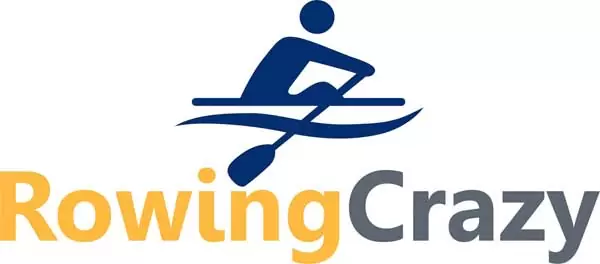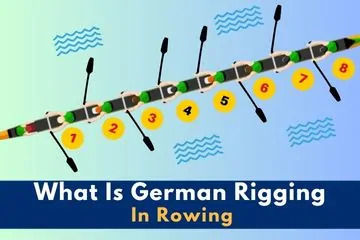
Hi friends! It’s Petra, and today, I want to discuss a subject that isn’t discussed frequently but I suspect we might be seeing/hearing more of it in the future.
German rigging, sometimes referred to as bucket rigging or tandem rigging, is an old idea that has taken on new life after Oxford University won a race against Cambridge after bucket rigging seats 4 and 5.
What is German Rigging?
In a nutshell, rather than have seats alternate from side to side, you “rig” at least two seats to be on the same side.
For German rigging, those would be seats 4 and 5 or sometimes 5 and 6.
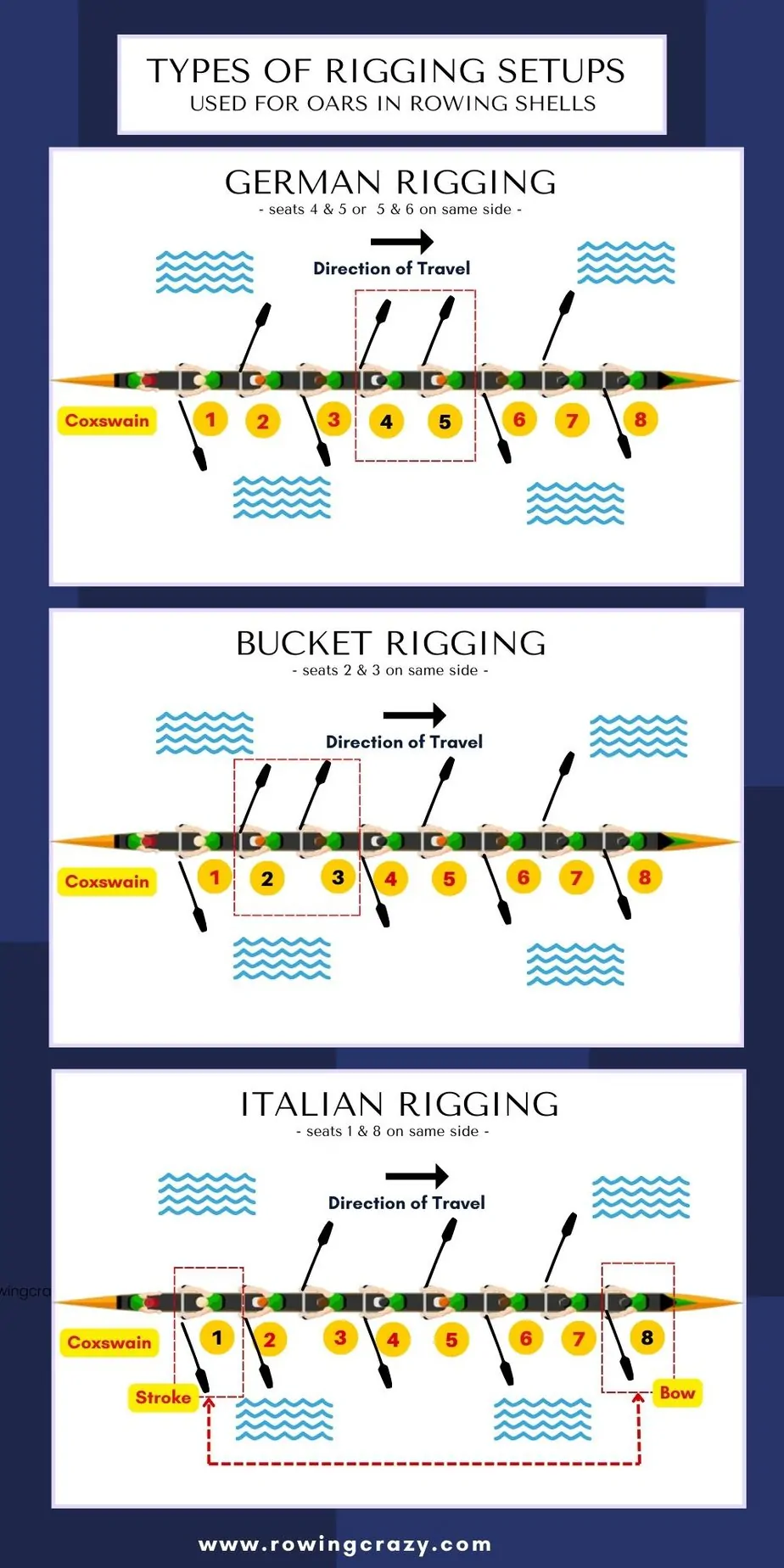
If you hear the phrase Italian rigging, this means the bow and stroke seats are on the same side.
Bucket rigging often refers to seats 2 and 3 being on the same side.
However, I’ve also heard people refer to German rigging with seats 2 and 3 positioned on the same side.
I suppose these words are now interchangeable, but you get the idea.
Why would anyone bother doing such a thing? Let’s look into this a bit further.
What is the Purpose Behind German Rigging?
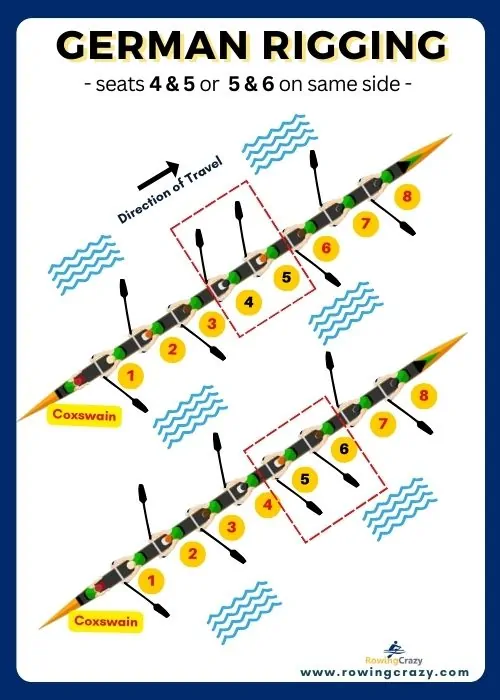
To our eyes, having an equal number of oars on each side looks neat and symmetrical, but symmetry doesn’t always mean balance in rowing.
Some people believe that having three oars on one side and five on the other makes the overall dynamics of the boat more efficient, leading to a faster shell.
It’s up to the coach or the coxswain to determine if all rowers are pretty much equal in strength and skill, and if this is the case, German rigging isn’t really necessary.
In most instances, however, there is an uneven power distribution among the team members. To even out the imbalanc, you can use this tandem rigging concept.
What are the Key Elements of German Rigging?

Of course, by changing the position of the oars, you also need to make a few other changes to truly make this process work, including:
-
Longer Oars: Many rowers prefer longer oars (if the rules allow) for greater leverage.
-
Higher Oarlocks: German rigging often involves higher oarlocks than what is considered traditional. This gives a more vertical stroke, changes how the oars interact with the water, and improves the dynamics.
-
Blade Angle: Some coaches will change the angle at which the oars (if longer than usual) enter the water to reduce drag from the oars’ extra weight.
Of course, the rules of each competition must be adhered to, and sometimes changing oar length is not allowed.
Does German Rigging Really Work?
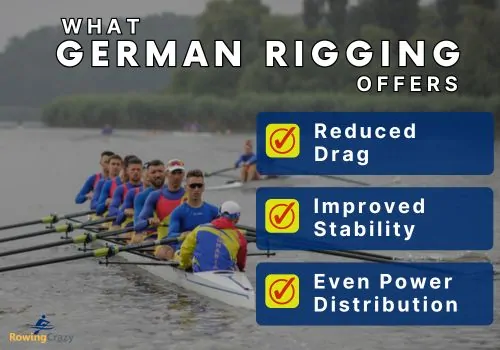
It can be extremely effective but not in every situation, which is why you don’t see it very often. Here’s what German rigging offers:
-
Reduced Drag. An uneven balance of power can cause drag. German rigging can reduce drag and improve efficiency.
-
Improved Stability. German rigging can help balance the boat and increase the stroke rate when rowing in rough or choppy water.
-
Even Power Distribution. When a crew has a combination of weak and strong members, having two strong rowers on one side is a more equitable distribution of power.
Many people believe that once rowers are accustomed to German rigging, they do better in competitions and feel more confident in their abilities.
Why Don’t We See More German Rigging?
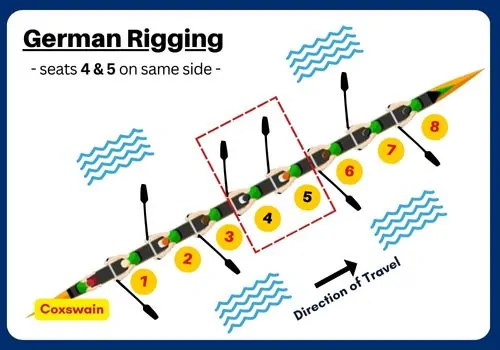
I would guess that we don’t see a great deal of German rigging because most coaches and coxswain choose rowers who are pretty much equal in skill and strength.
German rigging is only effective or necessary when you have several weak or weaker rowers and several very powerful rowers.
Coaches and coxswain will test out German rigging well ahead of a race before they decide to use this tactic and see how effective it is or isn’t, giving the team time to adjust to this new seating arrangement.
The Bottom Line on German Rigging
At the end of the day, whether you call it German rigging, Italian rigging, or tandem rigging, the whole point of this seating arrangement is to improve the balance of power. It works well when you have crew members with different abilities and strengths.
I hope I stated this clearly so that everyone has a better understanding of this seating arrangement and how it can help your team win your next regatta.
Written by Petra Amara – RowingCrazy.com
CEO & Founder of RowingCrazy, National Rower, Coxswain Womens Eight Team, Rowing Coach & Writer
Petra is a Mother of two and owner of Rowingcrazy.com. Petra lives and breathes rowing, she also has a passion for writing which lead her to start RowingCrazy.com to share her rowing experience and expertise with others.



